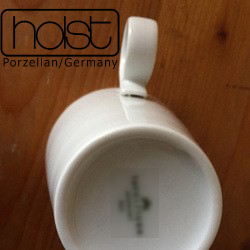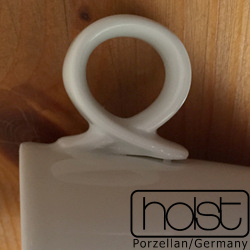Handle crack
 |  |
Demolition of handles on porcelain
The handle separates from the cup body with clean edges in the first phase of the handle break-off and shows open-pored surfaces. In the second phase, an additional mechanical load is required to "tear off" the rest of the handle. In rare cases, especially with inferior production quality, the handle and cup also separate completely smoothly. In such cases, it may be sufficient to simply lift a coffee mug filled with 100 - 200 g to complete the separation of the handle.
There are usually 2 reasons for this defect in the porcelain.
On the one hand, in conventional, handcrafted production of porcelain cups or mugs, due to a lack of care, usually too little or very irregular use of the porcelain slurry applied between the handle and the cup, so that in hard firing the cup and handle virtually melt into one piece.
On the other hand, in machine (large-scale industrialized) production, when the robot in its basic setting lacks "one milligram" contact pressure - especially in the case of non-cylindrical cup shapes with conical (see picture on the left) or bulbous form - in order to press a linearly designed handle web against a non-straight hollow body.
This appearance corresponds to the quality grade "C-sorting", because the drinking cup will lose its usefulness when used as intended. In other words: Whoever offers his guest such a drinking cup risks not only wet trousers, but also a claim for damages for a scalded "P" ...thigh!
